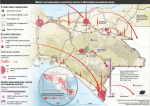Map. Mexico : The United States’ « third border »
Par , le 20 juin 2025.
Thomas Cattin is a PhD candidate in geography at the French Institute of Geopolitics (IFG) and at CentroGeo in Mexico. He is also head of the cartography department and Latin America specialist at the consulting firm Cassini Conseil. His research focuses on the conflict dynamics and local impacts of migration control policies on the borders of Mexico and the Southwestern United States.
While media attention remains focused on the border between the United States and Mexico — a symbolic staging ground for the Trump administration’s anti-immigrant policies — Thomas Cattin deftly shifts the focus over 3,000 kilometers south of the United States.
Since 2019, Mexico has been under intense pressure from the United States to stop the passage of undocumented migrants— mainly from Central America, South America and the Caribbean — through its territory. With 925,000 apprehensions in 2024, Mexico has become an important pillar in the architecture of US migration control policy. Remarkably, this control is exercised far from the US border, near Mexico’s southern border with Guatemala. There, the Mexican government has set up an extensive apparatus aimed at detecting, detaining, deporting and arresting migrants on their way north.
This annotated map helps to illustrate this dynamic. In addition, the document prompts reflection on the geopolitics of border control externalization.
Voir la version en français.
BRANDED as the "narco-state" that sparked the fentanyl epidemic in the United States, « bad hombres » responsible for urban crime, Mexico and its citizens have often served as scapegoats of current US President Donald Trump. Nevertheless, Trump has developed a surprisingly cordial relationship with Mexican President Claudia Sheinbaum since the start of his second term in office. Just last March, Sheinbaum narrowly managed to postpone a general 25% tariff on her country’s exports. In return, she committed to deploying 10,000 National Guard soldiers on the shared border to combat drug trafficking and clandestine immigration. Today, Mexico is a central pillar in the US strategy to control unauthorized migration flows from south to north — a strategy that is increasingly taking place far from the much-noticed and conflictual border between the two countries.

For the United States, Mexico is a roundabout solution to the ‘migration problem’
In the United States, clandestine immigration is an important axis of political polarization that is often instrumentalized in election campaigns. For the first time in 2016 and again in 2024, Donald Trump made the fight against irregular migration — which he often refers to as an "invasion" — the centerpiece of his campaign, mobilizing ethnonationalist rhetoric that blames Latin American migrants for rising crime rates and the socio-economic decline felt by parts of the population. This narrative deepens national divides in a country whose founding myths explicitly invoke a white, Anglo-Protestant identity, but whose population of European descent is expected to become a minority by 2050.
While Trump’s anti-immigrant discourse struggled to resonate beyond the electorate most affected by identity anxiety and economic insecurity in 2016, it had gained significant traction by 2024. At that point, 77% of Americans considered the situation at the Mexican border to be a major national issue.
Nearly 11.3 million people reside in the U.S. without legal status, a number that has remained relatively stable over the past fifteen years. However, in 2024 alone, the country recorded nearly 1.6 million attempts to cross the southern border [1], an evolution largely due to increased migration from Central America (Guatemala, Honduras, El Salvador), South America (Venezuela, Colombia) and the Caribbean (Cuba, Haiti). The phenomenon of Central American "migrant caravans"," which attracted a great deal of media attention around 2018, helped to publicize this trend.
The profile of these migrants — fleeing economic collapse, political persecution, violence or natural disasters — has also changed. Increasingly, it is families and unaccompanied minors who are making the dangerous journey, challenging a U.S. immigration system that has historically been designed to stop and deter the migration of single Mexican men in search of work. The solutions to this evolving crisis have proven even more divisive than the issue itself.
In Washington, partisan polarization over border policy has paralyzed any substantive reform of the immigration system. Despite its focus on strengthening border enforcement, the last bipartisan bill proposed by President Joe Biden was defeated in Congress in early 2024 due to Republican opposition. In the absence of permanent solutions, successive administrations have relied on temporary measures that often exacerbate the crisis at the border. This included the « Title 42 » [2], which was introduced by the Trump administration in March 2020 and extended by the Biden administration until May 2024. While this policy aimed to speed up deportations, it led to an increase in unauthorized border crossings and blocked access to the U.S. asylum system for migrants in need of humanitarian protection. In this context, the US has increasingly relied on Mexico to manage and contain these migration flows.
The increasing externalization of border control south of the Rio Grande
Mexico’s cooperation with the United States on border control is not a new development. It must be understood in the broader context of the asymmetrical relationship that has developed between the two countries for more than three decades. The establishment of the North American Free Trade Agreement (NAFTA) in 1994, which facilitated the free movement of goods and capital, also deepened the interdependence of the two countries’ economies. Today, over 80% of Mexican exports are destined for the US market alone. Maintaining this vital trade relationship explains why Mexican governments — regardless of their political color — have, to varying degrees and often under pressure, given in to US demands regarding border security and immigration enforcement.
After the terrorist attacks in New York on September 11, 2001, clandestine cross-border traffic became associated with the threat of terrorism. This shift enabled the redirection of significant resources to border security, which had now become a matter of national security. The US plan to extend its security perimeter beyond its own borders found a willing partner in the Mexican government, whose priority was to maintain cross-border trade. This convergence led to a series of bilateral agreements. The first of these, the 2002 “Smart Borders” agreement, marked a decisive moment : Mexico recognized border control as a “hemispheric security” issue and committed to strengthening migration control on its own territory.
The trend towards outsourcing migration control to Mexico accelerated under the Democratic administration of Barack Obama. Considering the increase in Central American migration, the US government decided to redirect some of the funds provided under the Mérida Initiative — a 2008 bilateral agreement to combat drug trafficking— - to securing Mexico’s borders. These funds were used to implement the Programa Frontera Sur, hastily launched by President Enrique Peña Nieto in 2014. The main objective of this initiative was to curb transit migration across Mexico’s southern border. Within a year, the Mexican authorities apprehended and deported more than 180,000 undocumented migrants — twice as many as in 2013.
In contrast to this security policy approach, Mexico’s left-wing president Andrés Manuel López Obrador, who took office in December 2018, initially advocated for a more humane policy based on development-oriented solutions. However, he soon gave in to threats from the Trump administration to impose tariffs if Mexico did not step up its efforts to enforce border controls. In June 2019, López Obrador announced the militarization of Mexico’s migration control strategy, underscored by the deployment of several thousand National Guard soldiers to key border regions. His government also quietly replaced dozens of high-ranking officials at the Instituto Nacional de Migración [3] (INM) with former military officers.
To deter migrants and demonstrate Mexico’s commitment to its task, the López Obrador government multiplied symbolic and concrete acts— from forcibly dispersing migrant caravans to threatening to deport "everyone, even those who come from Mars". Although this effective and performative repression eased somewhat with the election of Joe Biden, arrests by Mexican authorities continued to skyrocket, reaching a historic high of 925,000 arrests nationwide in 2024.
The externalization of US border control to Mexico has led to the development of a geo-strategy of migration control that has transformed the southeast of the country into a vast apparatus aimed at deterring, stopping, detaining and deporting undocumented migrants.
Mexico’s southern border : a geostrategic outpost of North American migration control
A quick look at the map shows the geostrategic importance of southeastern Mexico. The country’s southern border, which stretches 1,138 kilometers along Guatemala and Belize, is almost three times shorter than the 3,152-kilometer border with the United States and is therefore much easier and cheaper to control. Since the early 2000s, the Mexican government has been working on establishing a buffer zone to gradually curb Central American migration from the border south to the Isthmus of Tehuantepec, a narrow strip of land just 210 kilometers wide. Between 2018 and 2024, more than half of all apprehended migrants were apprehended in this region.
Importantly, the migration control apparatus is not located exactly at the border itself — whose geographical features make direct surveillance difficult — but along the main transportation routes that migrants are likely to use. Along these highways and railroads, the INM has set up checkpoints in collaboration with military units and sometimes local police. These range from simple roadblocks to the Centros de Atención Integral para el Tránsito Fronterizo (CAITF), full-fledged border checkpoints located approximately 50 kilometers deep within Mexican territory. The advanced biometric and scanning technologies used at these centers were partially funded by the United States.
Although these checkpoints are concentrated in southeastern Mexico, they now cover the entire country. Migrants intercepted in central or northern regions are often sent back to southern cities near the Guatemalan border like Tapachula — a tactic of disorientation and deterrence that is increasingly used to demoralize and confuse migrants.
Migrants who are apprehended by the Mexican authorities are sent to immigration detention centers, the so called “estaciones migratorias", where they await the resolution of their immigration cases. In a 2024 report by the Comisión Nacional de los Derechos Humanos (CNDH), these overcrowded centers are described as prisons where detainees are often forced to live in deplorable conditions and have limited access to medical care and legal aid. In the same year, a tragic fire at a center in Ciudad Juárez led to the deaths of 40 migrants and sparked a national scandal. Ironically named the 21st Century Station, the largest of these facilities is located in Tapachula and has a capacity of about 900 detainees.
Until recently, most Central American migrants apprehended in Mexico were deported. This was facilitated by bilateral repatriation agreements and the geographical proximity of their countries of origin, which kept costs relatively low. However, in December 2023, the federal government announced a temporary suspension of deportations due to budgetary constraints. Migrants from the Caribbean, South America and from outside the continent (72% of arrests in 2024) are less likely to be deported for both political and financial reasons. Instead of being sent back to their countries of origin, these migrants are increasingly immobilized in southern Mexico — far away from the US border.
As early as 2019, President López Obrador expressed his desire to supplement stricter migration control with employment opportunities for migrants in major infrastructure projects in the south-east of the country. However, this plan has largely failed. Most migrants have been left to fend for themselves in the country’s poorest region. While both the Mexican government and UN agencies have set up social assistance programs for migrants, access is often limited to those who apply for refugee status in Mexico. In Tapachula in 2022, the backlog of applications for refugee status was so great that it took four to six months to initiate the procedure. At that time, for most it was the only way to obtain a visa to move freely within Mexico.
It was not the economic opportunities, but the bureaucratic delays that turned Mexico’s southern border into a huge holding zone for thousands of migrants. This situation was exacerbated by the US government’s decision in August 2024 to extend access to the CBP One Mobile App exclusively to the Mexican states of Tabasco and Chiapas. As a result, migrants were forced to wait several months in the Southeast before they could even obtain an appointment to submit an asylum request at the US border. Since then, the app has been abolished by the Trump administration as part of its efforts to curtail the right to asylum.
A costly trade-off : human insecurity and the limits of external border control
Despite the Mexican government’s extensive efforts in the southeast of the country, control over unauthorized migration remains only partial and at the expense of the safety and rights of undocumented migrants, which under Mexican law are indistinguishable from those of citizens. With enough money, migrant checkpoints can be easily circumvented. Aside from the well-documented corruption of Mexican authorities, increased law enforcement along major transportation corridors has diverted migrants to more dangerous and remote routes. These detours often involve smugglers and can expose migrants to criminal violence and armed groups. Security conditions have deteriorated considerably in several regions along the migration routes, particularly due to increasing competition between drug cartels trying to gain territorial control.
At the same time, tensions have escalated in the cities where migrants are forced to wait, particularly in Tapachula. There, exclusionary behaviors and spatial segregation are on the rise as local actors mobilize to protect their city and neighborhoods from the perceived threats of migrants, replicating strategies of exclusion at the urban level.
Ultimately, the relocation of US border controls to Mexico has not stopped unauthorized migration. Rather, it has made the journey longer, riskier and less safe for migrants — all at Mexico’s expense. From a political perspective, however, this arrangement has given Mexico powerful leverage in negotiations with its northern neighbor at a time when the United States appears increasingly willing to reconsider decades of economic interdependence.
Copyright Juin 2025-Cattin/Cassini-Conseil/Diploweb.com
Plus
Voir la version en français.
 |
Titre du document : Map. Mexico’s southern border : a geostrategic outpost of North American migration control Design and production : Thomas Cattin. Voir la version en français. Document ajouté le 20 juin 2025 Document PNG ; 1685503 ko Taille : 1200 x 849 px Visualiser le document |
While media attention remains focused on the border between the United States and Mexico — a symbolic staging ground for the Trump administration’s anti-immigrant policies — Thomas Cattin deftly shifts the focus over 3,000 kilometers south of the United States.
Mots clés — Key words
Central America , Mexico , Map , Geopolitics , United States of America , Illegal immigration , Migration , Borders , GeographyPour ne rien rater de nos nouvelles publications, abonnez-vous à la Lettre du Diploweb !
[1] These figures take into account both migrants apprehended while attempting to cross the border illegally and those seeking legal entry who were deemed inadmissible.
[2] This was a measure taken in the context of the health emergency caused by the Covid-19 pandemic, which allowed for the immediate expulsion of irregular migrants without their cases being processed.
[3] The INM is the institution of the Mexican federal government responsible for enforcing migration policy at the borders and within the Mexican territory.
Direction

Directeur, P. Verluise
Conseil scientifique
Mentoring et coaching géopolitique
Présenter le Diploweb.com
Charte du site
Auteurs
Proposer un article
Retrouvez la chaîne Diploweb sur :








